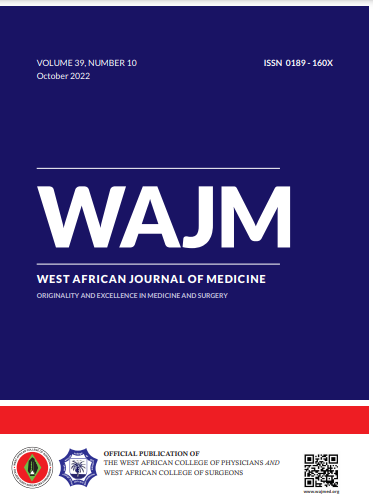ORIGINAL: Phenotypic Characterisation of Staphylococcus aureus Isolated from Patients in Healthcare Institutions in Zaria Metropolis, Kaduna State, Nigeria
West Afr J Med . 2022 Nov 30;39(11):1148-1155.
Keywords:
Antimicrobial resistance; Hospital patients; MRSA; Nigeria; Phenotype; S. aureus.Abstract
Background: Staphylococcus aureus is a cosmopolitan and pathogenic microorganism associated with various diseases spectra and antimicrobial resistance of public health importance.
Aim: This study determined the phenotypic characteristics of S. aureus isolated from patients in healthcare institutions in Zaria metropolis.
Study design: A cross-sectional hospital-based study was carried out in 5 healthcare institutions. Four hundred and twenty clinical samples were collected and analyzed.
Results: Majority of the patients (54.3%) were within the age range 21-40 years and mean age of 26.04 ± 12 years. Approximately, 70% of the respondents had history of antibiotic use prior to consultation in the hospitals and were self-prescribed, and 91.2% were outpatients. The most commonly abused antibiotics were ampicillin-cloxacillin (19.5%) and cotrimoxazole (10.0%), and the mean duration of their use was 3.5 ± 1.3 days. The detection rate for S. aureus was 10% and 5.2% for MRSA. The S. aureus isolates showed the highest frequency of resistance against ampicillin 42 (100%), followed by penicillin G 39 (92.9%) and least was to gentamicin 5 (11.9%). The frequency of resistance for the MRSA were ampicillin 22 (100%), penicillin G 21(95.5%) and least was to gentamicin 2 (9.1%). The minimum inhibitory concentrations of oxacillin were greater than 128 μg /ml.
Conclusion: The detection rate of S. aureus and MRSA strains are of great public health concern which requires continuous health education on rational use of antibiotics among others.
Keywords: Antimicrobial resistance; Hospital patients; MRSA; Nigeria; Phenotype; S. aureus.
I A Joshua 1, F J Giwa 2, J K P Kwaga 3, J Kabir 3, O A Owolodun 4, G A Umaru 5, A G Habib 6


